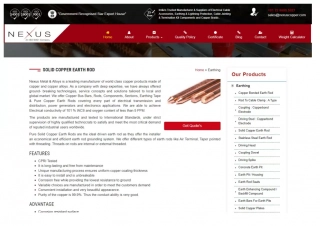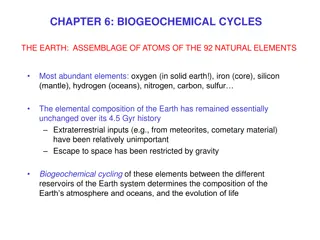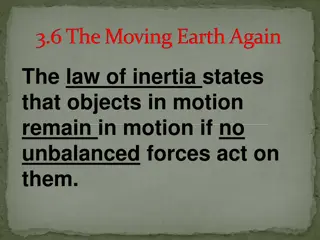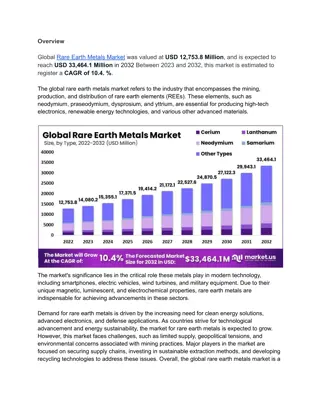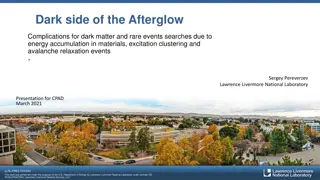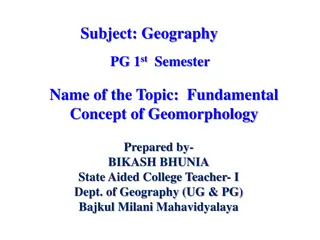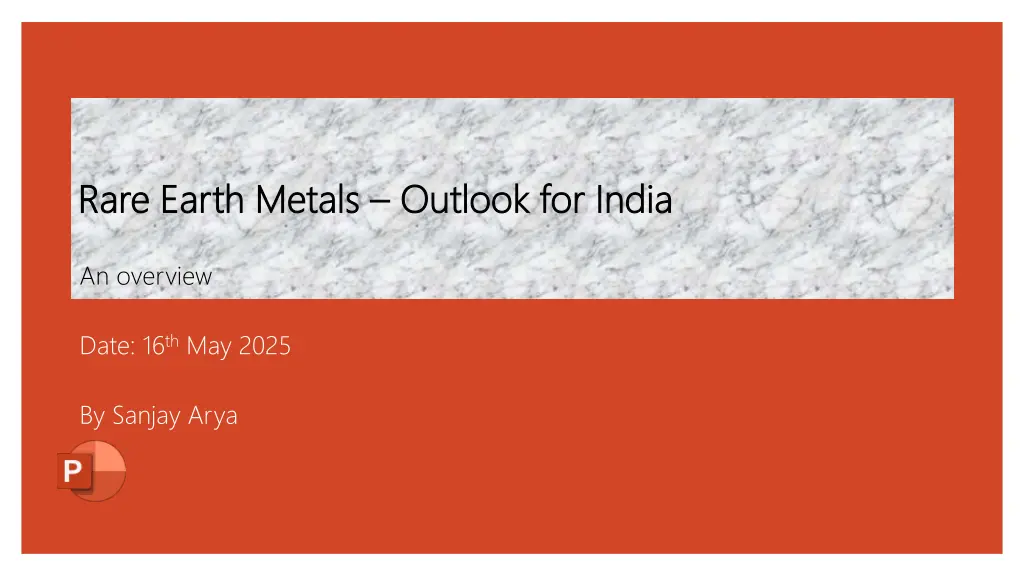
Rare Earth Metals Outlook in India: Opportunities and Challenges
Explore the significance of rare earth metals, their impact on India's economy, and the future growth prospects in this overview by Sanjay Arya. Discover how these essential elements drive innovation across various industries.
Download Presentation

Please find below an Image/Link to download the presentation.
The content on the website is provided AS IS for your information and personal use only. It may not be sold, licensed, or shared on other websites without obtaining consent from the author. If you encounter any issues during the download, it is possible that the publisher has removed the file from their server.
You are allowed to download the files provided on this website for personal or commercial use, subject to the condition that they are used lawfully. All files are the property of their respective owners.
The content on the website is provided AS IS for your information and personal use only. It may not be sold, licensed, or shared on other websites without obtaining consent from the author.
E N D
Presentation Transcript
Rare Earth Metals Rare Earth Metals Outlook for India Outlook for India An overview Date: 16thMay 2025 By Sanjay Arya
Welcome Dear Friends Would like to Thank you for joining me today at the Rare Earth Metals Conference. It s a privilege to speak in front of such an esteemed gathering of professionals and innovators who are passionate about the future of Rare earth Metals in this time. As we all know, Rare Earth metalsoften referred to as rare earth elements (REEs), are a group of 17 chemically similar metals that are critical to a variety of modern technologies. These elements include the 15 lanthanides, which are found in the f-block of the periodic table, plus scandium and yttrium. Today, I am excited to share my insights on the same, and how we can leverage our collective knowledge to drive innovations and address the challenges we face.
Indias GDP and Growth Overview India s GDP and Growth Overview Introduction India is one of the fastest-growing major economies in the world. As of 2023, India s nominal GDP is estimated at approximately $3.5 trillion, making it the fifth-largest economy globally. GDP Growth Rate India has experienced significant growth over the past few decades. Following a period of reforms in the early 1990s, the economy has averaged an annual growth rate of around 6-7%. In recent years, the GDP growth rate fluctuated due to various factors, including global economic conditions and domestic challenges, but it rebounded strongly post-pandemic.
Recent Trends Recent Trends As of 2025, India s GDP growth rate is projected to be around 6.5-7% as the economy continues to recover and benefit from structural reforms, increased foreign direct investment, and government initiatives aimed at boosting manufacturing and infrastructure. Key Sectors Driving Growth 1.Services Sector: Contributes to over 55% of GDP, with IT and business services leading the way. 2.Industry: Manufacturing and construction are showing robust growth, supported by the Make in India initiative. 3.Agriculture: Continues to be a significant sector, employing nearly half of the workforce, though its contribution to GDP is gradually declining.
Introduction: Definition of Rare Earth Metals Introduction: Definition of Rare Earth Metals Chemical Properties: Rare earth metals have unique magnetic, luminescent and electrochemical hemical Properties: Rare earth metals have unique magnetic, luminescent and electrochemical properties. properties. While they are called rare , many are relatively abundant in the Earth s crust. Though it is challenging to extract and separate from other minerals challenging to extract and separate from other minerals . Though it is Significance of Rare Earth metals They are essential in various applications; like, Electronics, Aerospace, Defence systems, Electric vehicles, Renewable Energy Technologies
Global Overview Global Overview Rare Earths Metal Market is valued at USD6.0 Billion in year 2024, and is projected to reach USD10.6 billion in year 2029 growing at the rate of 12.6% CAGR from 2024 to 2029. Major producers of Rare Earths Metals are China, USA, Vietnam, Australia, Myanmar. Small producing countries include India, Brazil, Madagascar etc. China account for 65-70% of total Production of Rare Earth Metals in the World. Major consumers of Rare Earth Metals are China, USA, Japan, EU etc. Current distribution Industry wise:
Worlds Production and Contribution World s Production and Contribution - - Country Country- -Wise Wise
Key Market Drivers: Key Market Drivers: 1.Automotive Industry Expansion: The usage of permanent magnets in the production of EV batteries is expected to drive the demand for rare earth elements over the forecast period. Neodymium and praseodymium based rare earth permanent magnets are majorly used for this purpose. 2.Aerospace Applications: Praseodymium is anticipated to witness a revenue CAGR of 10.7% over the forecast period. It is used as an alloying agent with magnesium to produce high strength metals for aircraft engines. 3.Electronics Growth: the product life cycles of consumer electronics and electronic gadgets are becoming shorter. Constant technology upgrades have resulted in either reuse or new demand for electronic gadgets and consumer durables 4.Other applications: Dysprosium is majorly used as an alloying agent in neodymium- iron-boron (Neo) permanent magnets. Neo magnets are widely used in various application industries, including transportation, power generation, aerospace & defense, medical and industrial.
Emerging Trends Permanent Magnets: With a growth of 11% expected till 2032, in value neodymium and praseodymium hold paramount importance in the rare earth elements industry for their use in manufacturing of permanent magnets. Lanthanum, with a projected growth of 8.6% by 20232, with its extensive use in nickel metal hydride rechargeable batteries. Lanthanum also plays a crucial role in glass and ceramic manufacturing. Regional Growth: Driven by the global decarbonization and electrification trend, demands for Nd may double or even triple in the next decades, with the clean energy technologies share of total demand rising significantly to over 40% for REE
Recent Developments in Production: Recent Developments in Production: In April 2024, U.S.-based MP Materials received USD 58.5 million for furthering the construction of the country s first integrated rare earth magnet manufacturing facility. The plant is located in Forth Worth, Texas, and is expected to begin commercial production by late 2025. In April 2023, India-based IREL (India) Ltd. announced that it plans to boost its mining capacity by 400% in the coming decade, thereby increasing its production to 13,000 tons from the existing 5,000 tons. In July 2023, USA Rare Earth announced its plans to invest USD 100 million to set up a neodymium magnet production facility in Stillwater, Oklahoma, with an initial 1,200 tons per annum capacity. Production is expected to commence by early 2026 and will be ramped up to 4,800 tons per annum.
Key growth areas of increase in Rare Earth consumption in India 1) Automotive industry expansion: As the automotive sector focuses on lighter and fuel efficient vehicles, the demand for EV batteries and eventual production of high quality batteries will increase demand. 1 2) 2 Aerospace and Defence: Particularly in creating strong alloys for aircraft engines and missiles, and in various electronic components. REEs like neodymium, dysprosium, and terbium are key ingredients in permanent magnets used in aircraft engines and other high-tech aerospace applications. 3 Consumer Electronics: Rising demand for consumer electronics, such as smartphones and laptops are also driving the growth of the industry. 4 Renewable Energy: Increasing demand for renewable energy sources, such as wind and solar power, is driving the growth of the rare earth industry
Consumption: 1) Majority of Rare Earth metals are currently imported into India. China being the biggest supplier of Rare Earth Metals in ingots and other forms. Consumption of Rare Earth Metals still lower than other large Industrial nations. The biggest consumption growth will come in from Automotive Electric Vehicles, Electronics, Aerospace and related industries. Just for reference, presently 25 Electric Vehicle manufacturers are there in India. This number has increased in few years from under 10. More new manufacturing companies, Indian and across the world are planning to start making cars and electronic components in India.
Future Trends and outlook Technological advancements in mining and processing that could lead to more efficient production methods. Under Make in India Government policy and initiatives aimed at boosting domestic production capacity and reducing dependency on imports. Global demand for rare earths, particularly in technology and renewable energy sectors, is influencing consumption and production levels in India. Government initiative towards development indigenous aircraft for commercial and defence use. In addition to rapid growth in aero space, where private companies are encouraged to participate.
Rare Earth Production and Deposits India has significant reserves of rare earth elements (REEs), with an estimated 6.9 million metric tons of rare earth reserves, accounting for 6% of the world's total reserves. The country ranks fifth in the world in terms of rare earth reserves, after China, Vietnam, Brazil, and Russia . Rare Earth Reserves in India: o Total Reserves: 6.9 million metric tons o Global Ranking: 5th o Percentage of Global Reserves: 6% o Main Sources: Monazite-bearing beach sand deposits in Kerala, Tamil Nadu, Odisha, Andhra Pradesh, Maharashtra, and Gujarat o Available REEs: Lanthanum, Cerium, Neodymium, Praseodymium, and Samarium o Unavailable REEs: Dysprosium, Terbium, and Europium (classified as Heavy Rare Earth Elements)
Key Facts Key Facts India produces less than 1% of the world's total rare earth output, despite having significant reserves. The country relies heavily on China for rare earth imports, with 60% of imports coming from China. Indian Rare Earths Limited (IREL) has a monopoly on rare earth production in India, but the government is working to encourage private investment and partnerships to develop the sector. The total monazite resources in India are estimated to be around 11.93 million tonnes, with monazite containing 55-60% total Rare Earth Oxide. Additionally, India has 13.07 million tonnes of in-situ monazite deposits
Main Players in Indian Market Main Players in Indian Market India has a significant presence in the rare earth industry, with several key players involved in mining, refining, and producing rare earth elements and compounds. Here are some notable rare earth producers in India. Indian Rare Earths Limited (IREL): A Public Sector Undertaking under the Department of Atomic Energy, IREL is the sole producer of rare earth compounds in India. They operate several units, including: Odisha Sand Complex (OSCOM): A rare earth extraction plant in Odisha that produces mixed rare earth chloride. Rare Earth Division (RED): A plant in Aluva, Kerala, that produces high-purity rare earth oxides and compounds. Manavalakurichi unit: A unit in Tamil Nadu that produces high-purity individual rare earth compounds. Rare Earth Permanent Magnet (REPM) Plant: A plant in Vizag that produces rare earth permanent magnets. Toyotsu Rare Earths (India) Pvt. Ltd.: A company that has partnered with IREL to create a critical minerals supply chain and remarket rare earth oxides and carbonates. Rare Earth Minerals: A company based in Rajsamand, Rajasthan, that processes, supplies, and exports rare earth minerals like abrasive garnet sand, quartz stone, and quartz powder. These companies contribute to India's growing rare earth industry, which is expected to play a significant role in
Production Forecast in India: Production Forecast in India: Metric Tons (Forecast) Year 2028 3081.20 2027 3028.49 2026 2974.71 2025 2919.83 2024 2863.83
Current imports for Metallurgy use: MTS Year 2023 2023 2023 2023 2023 2023 2023 2023 2023 2023 2023 2023 Month JANUARY FEBRUARY MARCH APRIL MAY JUNE JULY AUGUST SEPTEMBER OCTOBER NOVEMBER DECEMBER yearly 32.00 77.00 92.00 82.00 62.00 111.00 33.09 19.00 67.00 94.26 72.00 155.00 896.35 2022 YEARLY IMPORT 2022 JANUARY 4% 2%6%5% 16% 2022 FEBRUARY 7% 7% 7% 2022 MARCH 19% 2022 APRIL 2022 MAY 9% 12% 6% 2022 JUNE 2022 JULY 2022 AUGUST 2023 YEARLY IMPORT MTS Year 2024 2024 2024 2024 2024 2024 2024 2024 2024 2024 2024 2024 Month JANUARY FEBRUARY MARCH APRIL MAY JUNE JULY AUGUST SEPTEMBER OCTOBER NOVEMBER DECEMBER yearly 85.00 85.00 82.00 84.00 93.50 86.00 91.00 68.00 20.00 12.00 12.00 55.00 773.50 2023 JANUARY 4%9% 2023 FEBRUARY 17% 10% 2023 MARCH 8% 9% 2023 APRIL 11% 7% 2023 MAY 7% 2% 12% 4% 2023 JUNE 2023 JULY 2023 AUGUST
China Rare Earth Metals exports and challenges: China remains the biggest supplier of Rare Earth Metals to the World as evident from chart on right side. Exported 55,431mt in 2024 which is up by 6.0% from previous year. China exported 23,471.9mt of Rare earth oxides in 2024 76.2% of Rare Earths were exported to USA, Japan, EU and Taiwan alone. China production increased rapidly in last 10 years With changing political landscape and resultant export restrictions and tariff / trade wars imposed by Governments, it is yet to be seen what future holds. As supply gap created in short term will lead to serious uncertainties.
Summary As we ve explored today, Rare Earths metals are not Rare in usage but these are versatile material with significant potential across various industries. From automotive to aerospace to defense to cutting edge technology, the opportunities for further innovation are immense. I encourage you to take an active part in the discussion following my presentation. Your questions and perspectives are invaluable as we work together to explore new opportunities within our field.
Future Cooperation and overcoming misunderstanding Future Cooperation and overcoming misunderstanding China and India are the biggest markets today in terms of population and are neighbors. Neighbors are the first one to help each other in the time of need, and first to celebrate each other success. It is admirable to see huge shift in China from pure hardcore industrialization to high tech industrialization. China has shown the world how it is done the best way. We as neighbors and fellow Asians are in admiration of you. It is time to overcome miscommunication and misunderstanding between us and time to cooperate with each other. Our leader recently said, it is time for peace and not war. Taking this further, it is time for cooperation to seek and give support in mutual growth and benefit. Friends, we seek your help with technology to INCREASE PRODUCTION OF RARE EARTH MetalS in India, as partners let us grow together further.
Concluding remark: - We have come a long way in short time from iron and steel vehicles and low tech gadgets to faster, lighter, stronger transport & gadgets. Steel & aluminium and its alloys were driving this revolution. Next revolution, which has just started, in high technology sector will be riding on the strength of lighter and stronger metals with key support from Rare Earth Metals and oxides. - Changing dynamics and rapid pace of Technological advancements is shaping our world. With arrival of AI, we will soon be in our cars flying from one place to another. With its qualities I believe we have just scratched the surface of Rare Earths potential and usage. I Thank Asian Metals for giving this opportunity to be among you and present my views on Rare Earth metals growth story. Also thanks to Ms. Vivian and my colleague Ms Jagruti for helping out with some of the key ingredients of this presentation and to some of the papers & data published by some renowned publications of India and World.
Brief Introduction Brief Introduction DK Metal World Limited was established in Hong Kong, as one of the Director myself Sanjay Arya has over 34 years of experience in International trading of various metals, ores, ferro alloys etc. China and India have been integral part of our business activities. Over the years, we have made some very good friends in China, professionally and more importantly personal friends who have been always there in our good and not good times. Apart from trading in metals, minerals and alloys, our group of companies are involved in Processing of metals and metal plating for various industries in India. Group has recently established USA registered company to actively involve in metals trade to and from USA.


